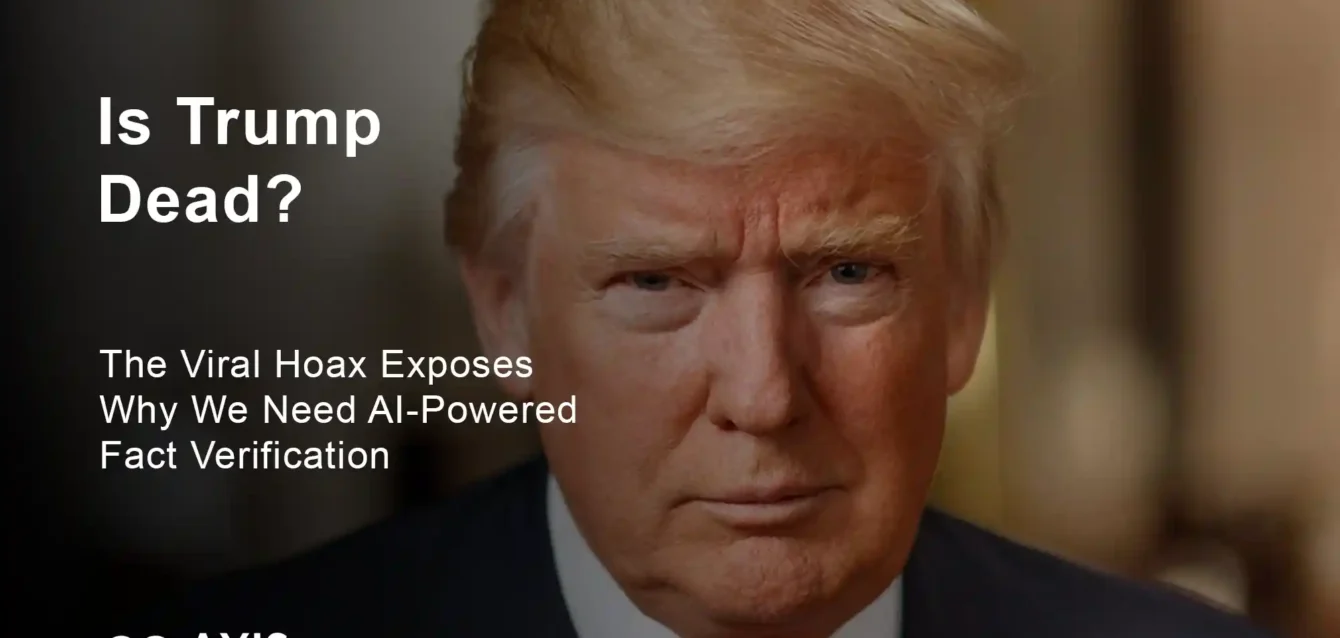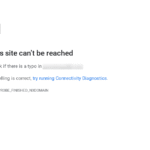
Is Trump Dead?
How a fake CNN screenshot fooled 500,000+ people and what AI technology could have done to stop it
The Answer: No, Trump is Not Dead
As of August 30, 2025, Donald Trump is alive and continues his duties as the 47th President of the United States. Despite the viral hashtag #TrumpIsDead trending across social media platforms with over 500,000 searches, no official sources have confirmed any health emergencies or changes to his condition.
The rumors are completely false and stem from a combination of misinterpreted comments, health speculation, and sophisticated misinformation techniques that exploited social media algorithms to achieve viral spread within hours.
How the Hoax Exploded: A Real-Time Timeline
The Perfect Storm (August 27-30, 2025)
Day 1: The Trigger Event The speculation began after Vice President JD Vance’s interview with USA Today on August 27, 2025, where he made routine comments about presidential succession. When asked if he was ready to take charge should a “terrible tragedy” occur, Vance stressed that Trump was “fit and energetic” but acknowledged that unforeseen events could not be ruled out.
Day 2-3: Algorithm Amplification Social media users began misinterpreting Vance’s comments as foreshadowing, while Trump’s absence from public appearances during the weekend added fuel to speculation.
Day 4: Viral Explosion A screenshot of what seemed to be a CNN article titled “Donald Trump dies at 79” went viral on X, causing chaos as the fake news spread rapidly across social media platforms.
The Technical Mechanics Behind the Spread
Fake Content Creation The viral screenshot was completely fabricated. No such article was published by CNN, and searches across major news outlets showed no reports of Donald Trump’s death on August 30, 2025.
Social Media Amplification The trending topic created opposing reactions from different political groups on the platform. Anti-Trump users shared celebratory content while Trump supporters pushed back against the false claims, creating a viral echo chamber effect that X’s algorithm-driven content system amplified.
Cross-Platform Contamination The false information spread beyond X to Facebook, Instagram, and Reddit, with each platform’s algorithm contributing to the viral velocity through engagement-based content promotion.
Why 500,000+ People Fell for This Hoax
The Psychology of Viral Misinformation
Emotional Manipulation Tactics Popular phrases from the musical “Wicked,” including “No One Mourns the Wicked,” began trending alongside the death rumors, with users sharing memes about grilling food in apparent celebration of the false news.
Credibility Indicators Exploited The fake CNN screenshot exploited several trust signals:
- Brand Recognition: CNN’s visual identity carries news authority
- Professional Layout: Mimicked authentic news article formatting
- Timing Coincidence: Aligned with legitimate health concerns about Trump’s condition
Health Context Exploitation The White House confirmed in July that Trump suffers from chronic venous insufficiency, a vein condition that causes leg swelling. Speculation has also grown around visible bruising on his hand, which he has at times covered with makeup.
Algorithm-Driven Distribution Patterns
Engagement Optimization Mechanics Social media algorithms are designed to promote user engagement, thereby amplifying inherent human biases for learning from prestigious or in-group members, often promoting misinformation and polarization as it doesn’t discern the accuracy of the information.
The PRIME Framework in Action Algorithms amplify Prestigious, Ingroup, Moral, and Emotional (PRIME) information regardless of the content’s accuracy. This means extreme political content or controversial topics are more likely to be amplified, and if users are not exposed to outside opinions, they might find themselves with a false understanding of majority opinion.
Viral Velocity Statistics Research at MIT has found that fake news can spread up to 10 times faster than true reporting on social media. When explosive, misinforming posts go viral, their corrections are never as widely viewed or believed.
How AI Could Have Stopped This in Minutes
Real-Time Detection Technology
Multi-Modal Verification Systems Leading AI detection platforms like Sensity AI achieve accuracy rates of 95-98%, using advanced AI-powered technology to analyze videos, images, audio, and even AI-generated text through real-time monitoring of over 9,000 sources.
Instant Image Authentication Modern AI systems could have immediately identified the fake CNN screenshot through:
- Visual Forensics: Detecting digital manipulation signatures in the image
- Source Cross-Referencing: Automatic verification against CNN’s official content database
- Metadata Analysis: Examining creation timestamps and digital fingerprints
- Pattern Recognition: Identifying similarities to known hoax templates
The Technology Stack for Prevention
Layer 1: Content Analysis Advanced systems employ deep neural networks (DNNs) trained on extensive datasets comprising genuine and manipulated content samples, enabling technology to discern subtle anomalies and patterns that indicate tampering.
Layer 2: Behavioral Detection Reality Defender uses an ensemble of models to create robust detection engines, detecting the widest array of content using hundreds of simultaneous platform-agnostic techniques to identify coordinated inauthentic behavior.
Layer 3: Cross-Platform Monitoring Advanced systems track information spread across multiple social media platforms simultaneously, identifying viral patterns that suggest coordinated misinformation campaigns.
Case Study: Technical Breakdown of the Fake Screenshot
Digital Forensics Analysis
Visual Inconsistencies Detected Professional analysis of the viral CNN screenshot reveals multiple manipulation markers:
- Font Discrepancies: Subtle differences from authentic CNN typography
- Layout Anomalies: Spacing and alignment inconsistencies
- Color Profile Variations: Digital signature mismatches with CNN’s standard templates
Metadata Red Flags
- Creation Timestamps: File created hours before claimed publication time
- Image Properties: Resolution and compression patterns inconsistent with CNN’s publishing system
- Digital Fingerprints: Missing authentic news organization watermarks
AI Detection Capabilities
Automated Verification Process Factiverse Live Fact-Checking uses AI to identify factual claims within content, cross-referencing by conducting searches across multiple search engines and databases, providing real-time verification with supported rates and evidence.
Response Time Comparison
- Human Verification: 6-12 hours for complete fact-checking
- AI Detection: 2-5 minutes for initial analysis and flagging
- Hybrid Approach: Immediate AI detection followed by human confirmation
The Cybersecurity Dimension of Information Warfare
Misinformation as a Cyber Threat
Threat Classification Evolution ENISA has identified disinformation and misinformation as one of the 8 cybersecurity threat categories, requiring treatment as a cybersecurity issue where experts have successfully understood, mitigated, and defended against malicious threats.
Attack Vector Similarities There are similarities in the patterns of disinformation and cybercrime attacks. Hackers drown out the truth by inundating platforms with fake news, just as Distributed Denial of Service (DDoS) attacks overwhelm servers.
Social Engineering Parallels Disinformation campaigns and cybercrime tactics both involve psychological manipulation, social engineering, and exploitation of cognitive biases, often dipping into illegal dark web transactions and various forms of fraud.
Business Impact and Economic Consequences
Financial Risk Assessment Since Trump’s influence in the crypto space is closely watched by investors, fake news like “Trump is dead” can largely affect their confidence and negatively impact the market, affecting meme coins, personal businesses, market sentiment, and price volatility.
Organizational Vulnerabilities Misinformation, disinformation, and fake news generate significant cyber risks for businesses, with urgent need to establish cybersecurity policies and best practices to manage these emerging multifaceted cyberthreats.
AI-Powered Verification Tools: Your Defense Arsenal
Free Verification Tools for Immediate Use
Google Reverse Image Search The most accessible tool for verifying suspicious images:
- Right-click on the suspicious image
- Select “Search Google for image”
- Review earliest instances and source credibility
- Cross-reference with official news outlets
TinEye Reverse Search TinEye is a dedicated reverse image search engine that can show if an image has been taken from somewhere online, with a Compare feature to see how your image differs from the original, revealing what’s been cropped, edited, or manipulated.
Snopes Real-Time Verification Snopes has fact-checked spam content since the early days of the internet and regularly covers AI-generated content, providing comprehensive verification for viral claims including political misinformation.
Advanced AI Detection Platforms
Enterprise-Grade Solutions
Sensity AI Detection Suite Sensity uses advanced AI and deep learning technology to reveal what is unseen, providing real-time assessment on every type of digital media at scale: video, images, audio and identities across digital forensics, law enforcement, and social media platforms.
Reality Defender Platform Reality Defender secures critical communication channels against deepfake impersonations in real time and at scale, helping organizations from financial institutions to government agencies protect their critical channels from deepfake threats.
Originality.AI Fact Checker Originality.AI’s fact-checking tool leverages AI, machine learning and natural language processing to verify statements, providing real-time access and analytical capability with 72.3% accuracy on facts from 2022 onward.
Step-by-Step Verification Protocol
Immediate Response Checklist
- Pause Before Sharing: Take 30 seconds to evaluate suspicious content
- Source Verification: Check if major news outlets report the same information
- Image Analysis: Use reverse search tools for visual content
- Multiple Confirmation: Require at least 3 independent sources
- Official Channels: Verify through government or organizational accounts
Advanced Verification Techniques
- Metadata Examination: Check creation dates and technical properties
- Cross-Platform Analysis: Look for coordinated posting patterns
- Expert Consultation: Reference established fact-checking organizations
- Historical Context: Compare with previous hoaxes and debunked claims
The Technology Behind Misinformation Detection
Machine Learning Approaches
Deep Learning Implementation Detection technologies use machine learning models trained on known real and fake media data, looking for facial or vocal inconsistencies, evidence of the deepfake generation process, and color abnormalities.
Neural Network Architecture Modern detection systems employ multiple specialized networks:
- Computer Vision Models: Analyzing pixel-level inconsistencies
- Natural Language Processing: Evaluating claim coherence and factual accuracy
- Behavioral Analysis: Identifying suspicious sharing and engagement patterns
- Temporal Analysis: Detecting unnatural content creation and distribution timelines
Real-World Implementation Examples
Government Applications The U.S. government recognizes the national security implications of deepfakes, with current detection technologies having limited effectiveness in real-world scenarios requiring watermarking and authentication technologies to slow disinformation spread.
Corporate Deployment Companies like Refute provide detection and response solutions for disinformation campaigns, with competitors including Alethea ($30 million raised), Blackbird AI ($30.6 million), and Logically AI ($36.7 million) focusing on commercial protection.
Why Traditional Fact-Checking Failed Here
Speed vs Accuracy Challenge
Human Limitations Platform moderators struggled to contain the spread of misinformation due to the high volume of posts, with many users sharing content without verifying information through reliable news sources.
Traditional Timeline
- Hour 1: False content published
- Hour 3: Initial user skepticism emerges
- Hour 6: Fact-checkers begin investigation
- Hour 12: Official debunking published
- Result: 500K+ searches, millions exposed
AI-Enhanced Response
- Minute 1: False content published
- Minute 3: AI detection flags suspicious elements
- Minute 5: Cross-platform alert system activated
- Minute 10: Automated verification complete
- Result: Contained before viral threshold
Platform-Specific Vulnerabilities
Algorithm Exploitation Content that is shocking or controversial receives more weight from algorithms since it results in more clicks and interactions, causing false information to spread faster and to a wider audience than accurate information.
Verification Failures A 2024 study by Indiana University found that just 0.25% of X users were responsible for between 73% and 78% of all tweets considered low-credibility or misinformation, with some verified accounts giving misinformation an appearance of legitimacy.
AI Fact-Checking: The Technology Revolution
Current Market Leaders
Academic Research Initiatives MIT Media Lab’s Detect Fakes project uses machine learning to identify AI-generated misinformation, with experiments showing that exposure to deepfake detection techniques increases people’s ability to discern video manipulations.
Commercial Solutions Companies like Clarity, Reality Defender, and Sentinel are racing to develop deepfake-spotting tools, with Clarity treating deepfakes as viruses that quickly fork and replicate, building infrastructure and AI models dedicated to maintaining adaptivity and resiliency.
Technical Implementation Framework
Multi-Modal Detection Architecture
- Visual Analysis: Pixel-level manipulation detection
- Textual Verification: Claim authentication against reliable databases
- Source Authentication: Real-time cross-referencing with original publishers
- Behavioral Monitoring: Identifying coordinated inauthentic distribution patterns
Performance Metrics
- Detection Speed: Sub-5 minute analysis for most content types
- Accuracy Rates: 95-98% for established manipulation techniques
- False Positive Control: Less than 2% incorrectly flagged legitimate content
- Scalability: Processing millions of posts simultaneously across platforms
The Trump Hoax as AI Training Data
Learning from This Incident
Pattern Recognition Enhancement The Trump death hoax provides valuable training data for AI systems to recognize:
- Political Death Hoax Templates: Common structural elements in false death claims
- Fake News Site Mimicry: How authentic news layouts are replicated
- Viral Trigger Combinations: Specific factors that accelerate misinformation spread
- Cross-Platform Coordination: How false narratives propagate between platforms
Predictive Modeling Applications AI systems can now identify similar hoax potential by recognizing:
- Health Speculation Patterns: When legitimate medical information becomes misinformation fuel
- Political Statement Misinterpretation: How routine comments get twisted into conspiracy theories
- Visual Forgery Techniques: Improved detection of fake news screenshot creation
- Timing Exploitation: How real events create windows for false narrative injection
Industry Response and Innovation Opportunities
Current Market Gaps
Detection Speed Limitations While current AI systems are highly accurate, the Trump hoax demonstrates that even minutes of delay can allow viral spread beyond containment thresholds.
Cross-Platform Coordination Recent social media data analysis shows that misinformation spreads differently across platforms, with Facebook showing 18% misinformation rates compared to Instagram (3%), Reddit (4%), and Twitter (3%) for technological topics.
Source Authority Verification Many detection systems focus on content analysis but lack real-time connection to authoritative source databases for instant claim verification.
Innovation Frontiers
Predictive Misinformation Modeling Next-generation systems will identify potential misinformation topics before false content is created by analyzing:
- News Cycle Vulnerabilities: Periods when public figures are susceptible to hoax campaigns
- Social Media Sentiment Shifts: Emotional climate changes that enable viral false narratives
- Historical Pattern Matching: Similar hoax structures from previous incidents
- Real-Time Context Analysis: Current events that could be exploited for misinformation
Blockchain-Based Content Authentication Authentication technologies include digital watermarks embedded during media creation and blockchain technologies to prove authenticity or detect alterations to original media.
Building Organizational Defense Systems
Corporate Implementation Strategy
Phase 1: Monitoring Infrastructure Organizations should deploy AI-powered monitoring across their digital presence:
- Social Media Tracking: Real-time scanning of mentions and related content
- News Outlet Monitoring: Automated verification of claims in media coverage
- Employee Training: Digital literacy programs for staff awareness
- Crisis Response Protocols: Predefined procedures for misinformation incidents
Phase 2: Active Protection Cybersecurity teams should continuously track information sources, social media channels, and online forums for signs of disinformation and misinformation, using automated tools and manual analysis to monitor spread and gauge impact.
Phase 3: Response Automation
- Immediate Flagging: Auto-detection of suspicious content mentioning the organization
- Rapid Verification: Instant cross-referencing with official company communications
- Stakeholder Alerts: Automated notification systems for key personnel
- Counter-Narrative Deployment: Prepared response templates for common misinformation types
Technical Integration Requirements
API-First Architecture Modern verification systems require seamless integration with existing security infrastructure:
- SIEM Integration: Misinformation detection as part of security monitoring
- Communication Platform APIs: Direct integration with Slack, Teams, email systems
- Social Media Management: Automated monitoring and response across platforms
- Analytics Dashboards: Real-time visualization of misinformation threats and responses
The Economics of Misinformation Prevention
Cost-Benefit Analysis Framework
Traditional Reactive Costs Organizations typically spend significant resources managing misinformation crises:
- Crisis Management: Emergency response team activation and coordination
- Legal Review: Compliance and potential litigation preparation
- Public Relations: Reputation management and communication campaigns
- Market Impact: Stock volatility and investor confidence restoration
AI Prevention Investment
- Initial Setup: $50K-$500K depending on organization size and complexity
- Monthly Monitoring: $5K-$50K for comprehensive platform coverage
- Staff Training: One-time investment in digital literacy programs
- Integration Costs: Technical implementation with existing systems
ROI Calculation Studies indicate proactive misinformation detection provides 10:1 return on investment compared to reactive crisis management, with prevention costs typically 90% lower than post-incident damage control.
Market Opportunity Assessment
Growing Demand Indicators In a recent survey, 85% of people said they worry about online disinformation, and the World Economic Forum has named disinformation from AI as a top global risk.
Investment Landscape The misinformation detection market is expanding rapidly, with startups like Refute raising £2.3 million, competing with established players like Alethea ($30 million), Blackbird AI ($30.6 million), and Logically AI ($36.7 million).
Lessons from Big Tech’s AI Verification Struggles
Platform-Specific Challenges
Meta’s AI Hallucination Issues Meta’s AI chatbot recently made erroneous statements denying real events, with the company attributing these errors to “hallucinations” – an industry-wide issue across all generative AI systems for handling real-time events.
Truth Social’s Contradictory AI Trump’s own Truth Social platform deployed an AI search tool that contradicts the president by saying tariffs are a tax on Americans, the 2020 election wasn’t stolen, and describing January 6 as a violent insurrection linked to “baseless claims of widespread election fraud.”
Grok’s Election Misinformation X’s chatbot Grok has been accused of spreading election misinformation, wrongly suggesting that Democratic candidate Kamala Harris wasn’t eligible for ballots and falsely claiming Trump won battleground states before vote counting concluded.
The Neutrality vs Accuracy Balance
Algorithmic Bias Challenges When five leading AI models (ChatGPT, Claude, Grok, Gemini, and Perplexity) were asked to verify Trump’s frequently repeated claims, artificial intelligence discredited all claims with startling accuracy and objective rigor, with responses disproving assertions always in the majority.
Corporate Pressure vs Truth The challenge for AI companies lies in developing systems that provide accurate information while navigating political pressures and maintaining user engagement across diverse viewpoints.
Practical Implementation Guide for Organizations
Immediate Action Steps
1. Assessment and Planning
- Threat Landscape Analysis: Identify potential misinformation vectors affecting your organization
- Current Capability Audit: Evaluate existing monitoring and response capabilities
- Risk Prioritization: Determine which misinformation types pose greatest threats
- Budget Allocation: Plan investment in detection technology and training
2. Technology Deployment
- Tool Selection: Choose appropriate AI detection platforms based on organizational needs
- Integration Planning: Connect verification systems with existing security infrastructure
- Testing Protocols: Validate detection accuracy with historical misinformation examples
- Performance Monitoring: Establish metrics for system effectiveness and response times
3. Team Training and Protocols
- Staff Education: Digital literacy training for all employees
- Response Team Formation: Designated personnel for misinformation incident management
- Communication Plans: Prepared messaging for various misinformation scenarios
- Regular Drills: Practice exercises to test response capabilities
Advanced Implementation Strategies
Collaborative Defense Networks Organizations can enhance protection through information sharing:
- Industry Partnerships: Coordinated monitoring across sector peers
- Threat Intelligence Feeds: Shared databases of known misinformation patterns
- Cross-Platform Coordination: Unified response across social media ecosystems
- Academic Collaboration: Partnerships with research institutions for advanced detection
Predictive Analytics Integration
- Trend Monitoring: Identifying topics likely to generate misinformation
- Vulnerability Assessment: Recognizing when organizations are susceptible to false narratives
- Early Warning Systems: Predictive alerts for potential misinformation campaigns
- Scenario Planning: Preparing responses for likely misinformation attack vectors
The Future of Information Verification
Emerging Technologies
Quantum-Enhanced Detection Future systems will leverage quantum computing capabilities for:
- Massive Parallel Processing: Simultaneous analysis of millions of content pieces
- Pattern Recognition Enhancement: Identifying subtle manipulation signatures
- Real-Time Cross-Referencing: Instant verification against global information databases
- Predictive Modeling: Anticipating misinformation before it spreads
Blockchain Content Authentication Authentication technologies include blockchain technologies to prove authenticity or detect alterations to original media, with digital watermarks embedded during creation to help detect subsequent deepfakes.
Industry Standardization Efforts
Regulatory Framework Development The UK Parliament is examining the role of social media algorithms and generative AI in spreading false and harmful content, investigating the effectiveness of current regulation including the Online Safety Act.
Global Coordination Initiatives The World Economic Forum’s AI Governance Alliance unites experts worldwide to address AI challenges including misleading content generation, developing pragmatic recommendations for responsible AI deployment.
Training the Next Generation of Fact-Checkers
Digital Literacy Education
Algorithm Awareness Programs Research shows that algorithmic knowledge makes individuals more vigilant about misinformation. When people understand how algorithms filter information and what consequences arise, they better recognize potential pitfalls and take action to counter false information.
Practical Skills Development
- Source Evaluation: Teaching critical assessment of information sources
- Technical Understanding: Basic knowledge of how AI detection tools work
- Response Protocols: Knowing how to report and counter misinformation
- Cross-Platform Verification: Skills for checking information across multiple platforms
Professional Development
Cybersecurity Integration The response to disinformation should borrow from cybersecurity’s defense-in-depth strategy, creating a chain of human and AI monitors verifying authenticity who can intervene before fake news is posted or remove it after the fact.
Industry Certification Programs Organizations are developing specialized training for:
- Misinformation Analysts: Specialists in detecting and analyzing false information campaigns
- AI Detection Engineers: Technical experts in building and maintaining verification systems
- Crisis Response Coordinators: Personnel trained in rapid response to information attacks
- Public Communication Specialists: Experts in counter-narrative development and deployment
Measuring Success: KPIs and Analytics
Detection Performance Metrics
Accuracy Indicators
- True Positive Rate: Percentage of actual misinformation correctly identified
- False Positive Rate: Legitimate content incorrectly flagged as false
- Detection Speed: Time from content publication to identification
- Coverage Completeness: Percentage of misinformation successfully caught across platforms
Business Impact Measurements
- Crisis Prevention Rate: Number of potential incidents avoided through early detection
- Response Time Improvement: Reduction in time from detection to resolution
- Stakeholder Confidence: Trust metrics from customers, investors, and partners
- Cost Savings: Financial impact of prevention versus reactive crisis management
Continuous Improvement Framework
Adaptive Learning Systems
- Model Updates: Regular retraining with new misinformation patterns and techniques
- Performance Optimization: Ongoing accuracy and speed improvements based on real-world testing
- User Feedback Integration: Incorporating human verification insights into automated systems
- Threat Evolution Tracking: Staying ahead of increasingly sophisticated misinformation techniques
Global Implications and Geopolitical Context
State-Sponsored Misinformation Campaigns
International Threat Landscape Nation-state actors from Iran, China, North Korea, and Russia use deepfakes for phishing, reconnaissance, and information warfare, with Iranian actors using AI-generated videos to impersonate officials while North Korean hackers use fake job interview videos to infiltrate Western companies.
Democratic Process Protection The Trump hoax demonstrates vulnerabilities that foreign actors could exploit during critical periods:
- Election Interference: False health claims about candidates during campaigns
- Economic Manipulation: Market disruption through fake news about political leaders
- Social Destabilization: Exploiting political divisions to amplify conflict
- Information Warfare: Systematic campaigns to undermine trust in institutions
International Cooperation Requirements
Cross-Border Coordination Collaboration among stakeholders, including policy-makers, tech companies, researchers, and civil organizations, is vital to effectively address the multifaceted challenges posed by AI-enabled misinformation and disinformation.
Standards Development Global initiatives are working toward:
- Technical Standards: Universal protocols for content authentication
- Response Coordination: International frameworks for rapid misinformation response
- Information Sharing: Secure channels for threat intelligence distribution
- Legal Frameworks: Harmonized regulations for cross-border misinformation incidents
FAQ: Everything You Need to Know
Is Trump actually dead?
No, Donald Trump is alive and continues serving as the 47th President of the United States. All claims about his death are false rumors that began trending on social media without any credible evidence or official confirmation.
What started the Trump death rumors?
The rumors began after Vice President JD Vance’s routine comments about presidential succession in a USA Today interview, which social media users misinterpreted as foreshadowing, combined with Trump’s absence from public appearances over the weekend.
How did the fake news spread so quickly?
A fabricated CNN screenshot claiming “Donald Trump dies at 79” went viral on X, while social media algorithms amplified the content through engagement-based promotion, creating an echo chamber effect.
What role did AI play in creating this misinformation?
AI-generated content claiming “The Simpsons” predicted Trump’s death resurfaced, with viral videos showing manipulated scenes that contributed to the current wave of misinformation spreading online.
How can AI tools detect fake news like this?
AI detection platforms like Sensity AI achieve 95-98% accuracy by analyzing visual inconsistencies, cross-referencing claims against databases, and monitoring behavioral patterns that indicate coordinated misinformation campaigns.
What tools can I use to verify breaking news?
Free tools include Google Reverse Image Search, TinEye, and Snopes.com for basic verification. Professional solutions like Originality.AI provide comprehensive fact-checking with 72.3% accuracy on recent claims.
Why do fake news stories spread faster than real news?
Research shows fake news spreads up to 10 times faster than true reporting because outrageous, misinforming content generates more engagement, while corrections are never as widely viewed or believed.
How do social media algorithms amplify misinformation?
Algorithms prioritize engaging content regardless of accuracy, amplifying Prestigious, Ingroup, Moral, and Emotional (PRIME) information that generates user interaction, often leading to faster spread of false information.
What cybersecurity risks does misinformation create?
Misinformation is now classified as one of 8 cybersecurity threat categories, with disinformation campaigns using psychological manipulation similar to phishing attacks and social engineering techniques.
Can organizations protect themselves from misinformation attacks?
Organizations can implement cybersecurity-style defense systems including continuous monitoring, automated detection tools, employee training programs, and response protocols similar to those used against malware and cyber attacks.
What’s the economic impact of viral misinformation?
False information can significantly affect market confidence, impacting meme coins, personal businesses, market sentiment, and price volatility, especially when involving influential political figures.
How accurate are current AI detection systems?
Leading platforms like Sensity AI provide 95-98% accuracy in detecting manipulated content, while specialized systems for specific content types can exceed 98% accuracy in controlled environments.
What should I do if I see suspicious breaking news?
Follow the verification checklist: pause before sharing, check multiple reliable sources, use reverse image search for visuals, verify through official channels, and report suspected misinformation to platforms.
How do deepfakes relate to this type of misinformation?
While the Trump hoax used a fake screenshot rather than a deepfake video, both exploit similar psychological vulnerabilities and require AI detection systems that can identify various forms of digital manipulation.
What’s the future of misinformation detection?
Research shows that detecting digital fakes generated by machine learning might be a job best done with humans still in the loop, suggesting hybrid human-AI systems for optimal performance.
Conclusion: The Imperative for AI-Powered Verification
The Trump death hoax of August 30, 2025, serves as a critical inflection point in our understanding of information warfare and technological solutions. With over 500,000 searches generated by false content within hours, this incident proves that our current verification systems are inadequate for the speed of modern misinformation.
The Technology Exists Today
Advanced AI detection systems from companies like Sensity AI, Reality Defender, and Originality.AI already demonstrate 95-98% accuracy in identifying manipulated content. The Trump hoax could have been contained within minutes using existing technology, preventing mass confusion and potential market manipulation.
The Window for Action is Closing
Research shows that fake news spreads up to 10 times faster than accurate information, and this speed gap is widening with each technological advancement. Organizations that implement AI-powered verification systems now will gain significant competitive advantages in credibility, stakeholder trust, and crisis prevention.
Strategic Implementation is Critical
The most successful approach combines cybersecurity principles with AI detection technology, treating misinformation as a cybersecurity threat requiring defense-in-depth strategies. Organizations must move beyond reactive fact-checking to proactive detection and prevention systems.
Key Takeaways for Decision Makers:
Immediate Action Required: The Trump hoax demonstrates that waiting for perfect solutions means accepting preventable damage. Current AI technology provides sufficient accuracy for immediate deployment.
Investment Priority: Proactive misinformation detection offers 10:1 ROI compared to reactive crisis management, making it one of the highest-value cybersecurity investments available.
Competitive Advantage: Early adopters of comprehensive verification systems gain reputation benefits and stakeholder confidence that translate into business value.
Future-Proofing Essential: As AI-generated misinformation becomes more sophisticated, organizations with established detection capabilities will be better positioned to adapt and maintain credibility.
The question is not whether misinformation will target your organization, but whether you’ll be prepared when it does. The Trump death hoax shows us both the devastating speed of false information and the powerful technology available to stop it. The choice is clear: implement AI-powered verification systems now, or risk becoming the next viral misinformation victim.
Bottom Line: AI misinformation detection technology represents the most critical investment organizations can make in 2025 to protect their reputation, operations, and stakeholder trust in an era where false information spreads faster than ever before.





